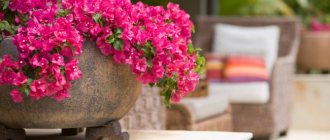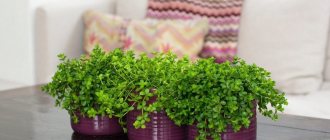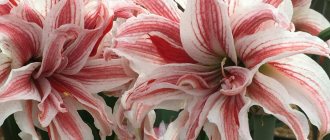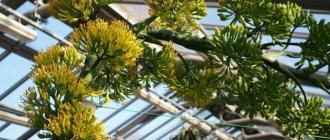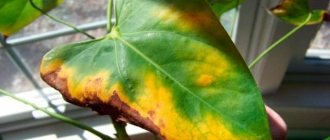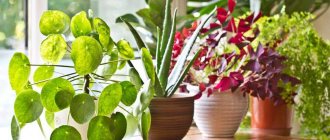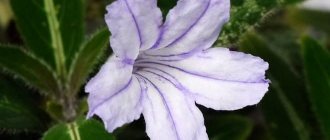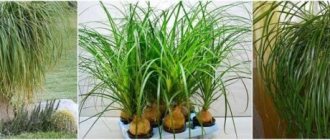Fittonia is a herbaceous perennial from the Acanthaceae family, native to South America, there are four species. Three of them have creeping, spreading stems, the fourth is erect. The name comes from the surname of the English sisters Fitton, who published the first biology textbook.
The flower grows in swampy areas, shady forests of Bolivia, Peru, Ecuador, where the climate is warm and humid. Flower shops offer hybrids obtained through selection, adapted to indoor conditions, the price varies from 100 to 500 rubles.
Description
Fittonia is a round-leaved flower with creeping, thin shoots, up to 10 cm long. The leaves are green, olive with scarlet, red, yellow, pink, silver-blue veins, reminiscent of a cobweb, connected by a small petiole to the stem. Their unusual color scheme is the main decoration of Fittonia.
The flowering plant produces spikelets once, in the summer. Small yellow flowers do not attract attention; it is recommended to pick them off. The plant is capricious and can grow in florariums and glass vessels. Photos of the flower look very impressive; it is kept as an ampelous, ground cover crop.
Bloom
In wild fittonias, the peduncle looks like a spikelet with inconspicuous gray-yellow or brownish small flowers. At home, Fittonia, being a product of selection, cannot bloom.
If the plant does decide to bloom, it is advisable to remove the peduncle before the buds begin to bloom. Flowering takes a lot of energy from the plant, the seeds will not ripen, and Fittonia will most likely die.
Types of Fittonia for indoor growing
Fittonia Verschaffelta or white-veined - about 25 cm high with branching stems, creeping shoots, and large leaves.
There are varieties:
- Silver-veined - with a bright silver mesh, smooth, oval leaf surface, up to 20 cm high, 10 cm long.
- Red - with streaks of pink, red, purple colors.
- Josan - wavy, green leaves with a coral mesh and dark edging along the edges.
- Perseus – light olive background and pastel web.
- White Anna is white-veined, a darker shade with a beautifully bordered stripe.
- The skeleton is small matte velvety olive leaves, a thick burgundy mesh.
- King Cross mosaic is another variety, similar to sea foam or lace, green edging, framed almost the entire white corrugated sheet.
- Pink Wayne is a rich emerald shade with white and pink veins.
- Fortissimo - small oval leaves with bright fuchsia-colored nets.
- Fittonia Mix - several varieties growing together, a decorative composition with many bright veins and different shades of leaves.
- Minima, dwarf - a species created for a bottle garden, florarium, it has miniature shoots with tiny leaves up to 2 cm. There are also varieties Tiger and Red Angel.
- Giant, large - difference in straight shoots, height - 60 cm. Leaves up to 16 cm long, up to 10 cm wide, short petioles. The shiny leaf blade is dark green with pink hues. Rarely grown at home.
- Hypoestes is a Fittonia-like flower from the Acanthus family. When comparing, it is easy to notice the differences: its leaves are larger, soft to the touch, bright spots over its entire surface, the stem is erect.
Plant characteristics
- Type : hanging or ground cover (depending on the growing option).
- Flower color : dull gray or taupe.
- Leaf color : from light green to rich emerald with noticeable white veins on the surface of the leaf.
- Need for sun : loves bright, but diffused light.
- Size : medium.
- Flowering : blooms rarely or not at all.
- Aroma : none.
Caring for Fittonia at home
Fittonia requires special care.
It is important to regularly drain the water from the pan and ensure that it is not over-dried or waterlogged.
Features of care depend on the time of year:
| Parameter | Spring Summer | Autumn winter |
| Location, lighting. | Bright, extended, with sun protection, east or west facing, away from air conditioning. | Additional artificial light for 2-3 hours a day. Do not place it too close to radiators; it is better to choose south-facing windows. |
| Temperature | +24…+27 °C, do not expose outside. | Not lower than +18 °C, do not allow sharp drops or changes. |
| Humidity | 80-90%, spray 2 times a day with warm filtered water, place a container with wet expanded clay, pebbles, or special moisturizing devices nearby. | |
| Watering | 3-4 times a week, immediately after the soil dries. | Water 2 times a week, every other day after the soil dries. |
| Feeding | From April to September - use mineral fertilizers once every 14 days, and liquid fertilizers per leaf. | Feeding is needed once a month with minerals. |
Features of planting and transplanting
Due to its rapid growth, the plant requires replanting in the spring. The flower must first get used to the new environment for 2-3 days, then it needs to be transplanted.
For planting, it is better to use a shallow, wide container with holes and neutral, light soil. Experts advise buying ready-made mixtures for violets or geraniums.
You can make the substrate yourself. Composition: two parts coniferous or turf soil, one part peat, sphagnum and coarse sand.
Step by step steps:
- Lay a drainage layer of 2/3: fine expanded clay, brick chips, crushed stone, pieces of foam plastic.
- Sprinkle a special mixture for decorative foliage crops on top.
- Remove the plant and shake it off without disturbing the roots.
- Transfer to a disinfected container. To do this, use a solution of manganese, vinegar essence, or chlorhexidine.
- Add the remaining substrate.
- Water, place in a bright, warm place, after draining the water from the pan.
Old, longer shoots in the spring need to be cut or pinched by 2/3 so that young ones grow. The plant must be mature, more than three years old.
Separately about transplantation
Fittonia is a fast-growing plant, so it is recommended to replant it every year, especially for young bushes. Adult flowers should be replanted once every 2-3 years.
For the procedure, you need to prepare a special soil, for which you take 3 parts of leaf soil and one part each of humus, sand and peat. It is necessary to provide good drainage in the pot.
The pot itself should be shallow and wide, because the roots of Fittonia are located superficially. An incorrectly chosen pot will slow down the growth of the bush or lead to a lack of flowering.
Pruning is important
To form a lush bush, you should pinch the tops of the shoots in a timely manner. This should be done with young plants. At 3-4 years, when the plant becomes somewhat outdated, its lower part becomes bare, which makes the appearance unattractive.
An overgrown plant can be rejuvenated by cutting off old shoots. You should not cut off all the shoots at once - the flower cannot remain completely without leaves. Cut off old shoots in stages, waiting for young shoots to appear.
Reproduction
The beauty of a flower encourages propagation, which occurs in three ways: dividing the bush, cuttings and layering. Each method should be considered in more detail:
1. Dividing the bush is the easiest way. For such propagation in the spring, when replanting the plant, it is necessary to divide the bush without damaging the root system - carefully straightening all the branches and distributing them into several flowerpots. Plant the separated bushes in different containers.
2. Propagation by cuttings - in spring or summer, cut off the apical shoot 6-7 cm long with several leaves. The cutting must be planted in damp sand or other soil, covered with a transparent cap (a jar, a cut plastic bottle), creating a greenhouse. For simplicity, you can put the cutting in water.
You should not pour a lot of water - the cutting must be saturated with oxygen. Cover the jar of water with a cap. The cuttings should be sprayed periodically so that they do not change their original appearance. When the cuttings have roots, they can be planted in a permanent place in a pot.
3. Propagation of Fittonia by layering is a somewhat complicated method and proceeds as follows: for propagation, you need to take a young shoot, clean it of excess leaves and dig it into the ground in this pot or substitute another one.
However, you should not separate it from the mother bush. After the shoot is securely rooted, it is separated from the original bush and grown as a separate flower.
Choose the most suitable method for propagation so that it takes as little time as possible. You should also be guided by the initial size of the bush - if it has reached a large size, use the first proposed method.
Top dressing
Fittonia should be fertilized with the onset of spring and during the period of active growth every 10-12 days. In winter, the plant does not need feeding.
Unlike other house flowers, fittonia does not require abundant fertilizer. What is required for any other flower should be divided into 2 parts, and this amount should be fed to this plant.
The best composition for fertilizer is complex mineral and organic fertilizers. You can purchase special, ready-made liquid solutions for indoor plants.
Care during flowering
Fittonia blooms in natural conditions in the spring, and grown at home, on a windowsill, in the summer. Peduncles appear directly from the leaves and have a greenish tint.
Flowering Fittonia is not valuable because its flowers are small and inconspicuous. They have a yellowish color, are collected in inflorescences in the form of ears and are odorless.
Flower growers who have experience growing the presented indoor plant simply pick off the flowers to improve the quality of the leaves.
Fittonia transplant, video:
Fittonia transplant. [Hope and Peace]
Reproduction
Cuttings - with three or five leaves, cut the cuttings with a sharp tool, leave the cuttings in a glass of water or aqua soil until roots form. Then plant in a mini-greenhouse, with a temperature of +25...+28 °C, cover with transparent film, glass, do not forget to open during the day, after rooting, transplant into a separate pot.
Most indoor flowers are propagated in this way - petunia, ficus, geranium, crossandra.
Division - divide the bush into parts, plant each in a separate pot, being careful not to damage the fragile roots.
To propagate by cutting, after tearing off the leaves, sprinkle the long stems with moist soil. A few weeks later, when the roots appear, they should be separated and planted in prepared pots.
Propagation by seeds is not so popular; this can only be done if there is very high-quality seed. In spring, it should be sown in pre-treated, moist soil, covered with film and placed in a lighted place with a temperature of +25 °C. After the sprouts appear, remove the film and pick after 3-5 leaves appear.
Priming
- Characteristics: nutritious, loose, able to retain moisture.
- Composition: humus, peat, leaf soil and sand in a ratio of 1:1:3:1.
- Drainage: expanded clay, pebbles, broken brick.
You can prepare the substrate yourself, but with this method there is a possibility that the soil will not be suitable due to the content of any impurities. In the store, choose a specialized substrate for fittonia.
Expert opinion
Mokhov Andrey Petrovich
Graduated from KubSAU, specialty: agronomy
Before planting, disinfect the soil: freeze or heat it. Additionally, saturate it with a solution of potassium permanganate.
Methods for keeping fittonia
There are several ways to grow Fittonia: flower pot, florarium, aquarium.
Pot
The container suitable for growth is low, up to 7 cm; place drainage and soil at the bottom. It is necessary to create lighting, watering, and humidity. The disadvantage of this method is that you will have to constantly monitor the level of humidity and temperature.
Florarium
For this method, it is preferable to use aqua soil or hydrogel. Instead of a pot - a bottle, an aquarium, a glass. Coconut fiber and expanded clay are for soil; the plant should not come into contact with the walls.
Pros:
- No need to monitor humidity.
- It is enough to water once a month.
- You can place other flowers there for contrast. But replanting and pruning should be done more often.
Aquarium
It requires special containers and equipment to maintain optimal conditions. Cons: slow growth, risk of root rot.
Breeding Features
- Capricious Fittonia reproduces best in the spring. Choose wet months for this - March and April.
- Monitor the condition of the soil - it should not be too wet or dry.
- Until Fittonia finally takes root, you can keep it in a warm place - close to radiators, on a windowsill on the sunny side, in the warmest room.
- The roots of the flower are superficial, so it is best to choose a low and wide container for planting.
- If, after the final rooting of the cutting or layering, you pinch the top, the Fittonia will begin to bush faster.
Tags: propagation Fittonia photo
FloraExpert 12/15/2016
Diseases and pests
If poorly cared for, the flower is susceptible to pests and diseases.
| Damage | Cause | Elimination methods |
| The plant stops growing, withers, the roots soften, and the flower dies. | Root rot. | Treat with drugs: Discor, Trichodermin, Baikal-M, according to the instructions, transplant. |
| There are green insects on the plant, the leaves are sticky, wither, and become deformed. | Aphid. | Spray with a solution of liquid soap, avoiding getting it on the ground. A liter of hot water will require 50 grams. laundry soap. Grind it, dissolve it in water, cool. |
| White coating on the surface. | Mealybug. | First, treat with an alcohol-soap solution. Dissolve 20 grams in a liter of boiling water. soap, cool, add 10 ml of alcohol. In advanced cases, use drugs: Aktara, Phosfamide, Kalipsa. |
| There are brown scales on the shoots, the leaves dry out and fall off. | Shield. | Place separately from other colors, use Actellik. |
| Small insects that drink the juice, areas of the leaf dry out, and holes appear in their place. | Thrips. | Immediately transplant the plant into new soil, wash the pot with laundry soap, and soak in a manganese solution. Treat the plant with Actellik, Karbofos, Fitoverma. |
| Holes appear in the leaves, light dots and cobwebs are visible on top. The leaves curl and dry. | Spider mite. | Isolate the flower, disinfect the tray, window sill, pot. The drugs will help - Omite. Aktofit, Aktellik. |
Problems with leaves
- They turn yellow, darken, dry out: insufficient humidity - spray more often.
- Droop, curl, shoots wither: insufficient watering - normalize the frequency and abundance.
- The tips turn pale and dry out: excess or lack of fertilizer; if you are not sure of the reason, replant.
- They become small and sparse, the shoots stretch out: lack of light - rearrange the flower or illuminate it with lamps.
- Light spots, the pattern fades: sunburn - move to a place with diffused light.
- Leaf falling: if the plant is older than 2 years and the lower leaves fall off, this is a natural process, in other cases it is a matter of lack of nutrients.
Mistakes in caring for Fittonia
Fittonia owners often make mistakes.
| Damage | Cause | Recommendations |
| The plant withers, dries, the leaves fall off. |
|
|
| Leaves are curled and have spots on them. | Lack of moisture. | Increase watering. |
| The lower part of the stem becomes bare. | The flower is aging. | Prune in spring. |
| Leaves dry out and turn brown or yellow. | The air is too dry. Little fertilizer. | Spray, put on a humidifier. Feed with mineral fertilizer for indoor flowers. |
| The plant stretches, the color turns pale. | Lack of light. | Keep in a brighter place, or use an artificial lamp. |
| The edges of the flower dry out. | Excessive or insufficient feeding. | Adjust the frequency of fertilization. |
Choosing a pot
- Since the root system grows in breadth, the container for the plant should be chosen wide and shallow. It can be either plastic or ceramic. A shallow ceramic pot works well for miniature cacti.
- One of the options is to plant Fittonia in florariums - transparent glass containers: aquariums, tall wide vases, large decorative transparent glasses with stems, and the like. Plants look very beautiful in such flowerpots. They are easy to maintain the required humidity and temperature. They protect well from drafts.
A layer of expanded clay or any other drainage should be placed at the bottom of any flowerpot to prevent waterlogging or drying out of the roots, which is equally harmful for Fittonia.
Fittonia - sleeping pills at home
In the Chinese teachings of Feng Shui, Fittonia is a symbol of the element of metal, helps to achieve your goal and get rid of indecision and depression, removes negativity, and improves your mood.
The plant brings benefits: it cleanses the air of microbes, saturates it with moisture, and can be kept in the bedroom for a relaxing holiday. The flower calms, helps relaxation, and helps you fall asleep quickly.
According to signs, Fittonia attracts money. People are convinced of this because of the appearance of the leaves, which resemble coins. The plant does not contain poisonous juice and is safe for the home.
A little history
Fittonia unites four ancient species of the Acanthaceae family and was named in honor of the English botanist sisters Sarah Maria and Elizabeth Fitton.
The flower was first brought to Great Britain in the mid-19th century from the tropical swamps of Peru, where it covered the ground with a bright fluffy blanket. Wild Fittonia did not take root well, isolated from the warm and humid climate of the tropics.
Thanks to selection, new, more resistant varieties have been developed. However, they, like a true capricious beauty, require maximum attention and careful care.
Fertilizing a flower
From spring to autumn, Fittonia needs fertilizing, which is applied to the soil twice a month. And in winter, feeding is done once every one to two months, and some gardeners do not feed the plant at all in winter. Complex fertilizers used for any indoor plant are suitable for Fittonia, but a weak concentration is needed, or store-bought fertilizers for decorative foliage plants are used. This flower does not tolerate excess fertilizer very well, so proper care is small portions of fertilizing.
What kind of illumination is needed?
The flower is not very demanding on lighting, since under natural conditions it grows in the forest and receives little light, however, the more intense and prolonged the lighting for Fittonia, the faster it will grow. In shaded conditions, the plant begins to fade, stretch out, and lose its attractiveness. It is advisable to place the flower on a western or southeastern windowsill. But even on a north window, the plant adapts and can feel comfortable. In summer, Fittonia does not tolerate bright sunlight well, and in winter it needs to be additionally illuminated with a phytolamp. Since the plant does not need a lot of light, the flower can be planted next to tall indoor plants. Different types of Fittonia require different lighting; by moving the pot with the plant to different points in the house, you can understand whether the flower has enough light or not.
